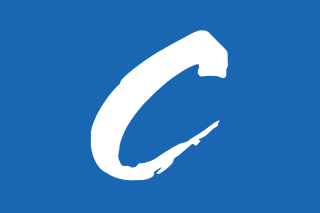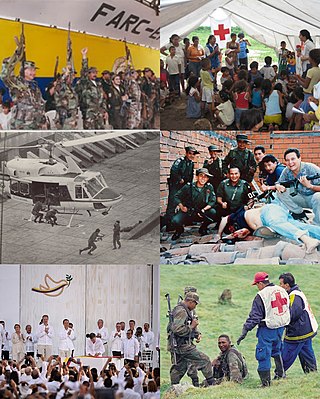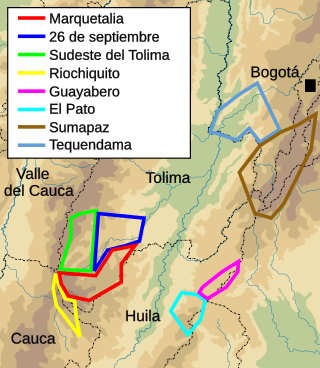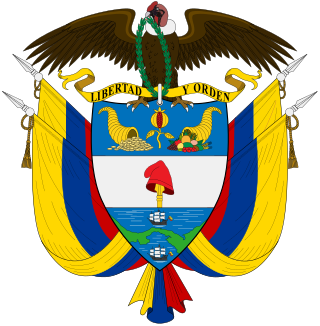The history of Colombia includes its settlement by indigenous peoples and the establishment of agrarian societies, notably the Muisca Confederation, Quimbaya Civilization, and Tairona Chiefdoms. The Spanish arrived in 1499 and initiated a period of annexation and colonization, ultimately creating the Viceroyalty of New Granada, with its capital at Bogotá. Independence from Spain was won in 1819, but by 1830 the resulting "Gran Colombia" Federation was dissolved. What is now Colombia and Panama emerged as the Republic of New Granada. The new nation experimented with federalism as the Granadine Confederation (1858) and then the United States of Colombia (1863) before the Republic of Colombia was finally declared in 1886. A period of constant political violence ensued, and Panama seceded in 1903. Since the 1960s, the country has suffered from an asymmetric low-intensity armed conflict which escalated in the 1990s but decreased from 2005 onward. The legacy of Colombia's history has resulted in a rich cultural heritage, and Colombia's geographic and climatic variations have contributed to the development of strong regional identities.

The Revolutionary Armed Forces of Colombia – People's Army is a Marxist–Leninist guerrilla group involved in the continuing Colombian conflict starting in 1964. The FARC-EP was officially founded in 1966 from peasant self-defense groups formed from 1948 during the "Violencia" as a peasant force promoting a political line of agrarianism and anti-imperialism. They are known to employ a variety of military tactics, in addition to more unconventional methods, including terrorism.

The Colombian Liberal Party is a centre to centre-left political party in Colombia. It was founded as a classical liberal party but later developed a more social-democratic tradition, joining the Socialist International in 1999.

The Colombian Communist Party is a legal communist party in Colombia. It was founded in 1930 as the Communist Party of Colombia, at which point it was the Colombian section of the Comintern. The party is led by Jaime Caycedo and publishes a weekly newspaper named Voz.

The National Liberation Army is a Marxist–Leninist guerrilla insurgency group involved in the continuing Colombian conflict, which has existed in Colombia since 1964. The ELN advocates a composite communist ideology of Marxism-Leninism and liberation theology. In 2013, it was estimated that the ELN forces consisted of between 1,380 and 3,000 guerrillas. According to former ELN national directorate member Felipe Torres, one fifth of ELN supporters have taken up arms. The ELN has been classified as a terrorist organization by the governments of Colombia, the United States, Canada, New Zealand, and the European Union.

Camilo Torres Restrepo was a Colombian Marxist–Leninist, Roman Catholic priest, a proponent of liberation theology, and a member of the National Liberation Army (ELN). During his life, he tried to reconcile revolutionary Marxism and Catholicism. His social activism and willingness to work with Marxists troubled some.

Pedro Antonio Marín Marín, known by his "nom de guerre" Manuel Marulanda Vélez, was the founder and main leader of the Marxist–Leninist FARC-EP. Marulanda was born in a coffee-growing region of west-central Colombia in the Quindío Department, to a peasant family politically aligned with the Liberal Party during conflicts in the 1940s and 1950s.

The Colombian Conservative Party is a conservative political party in Colombia. The party was formally established in 1849 by Mariano Ospina Rodríguez and José Eusebio Caro.
Democratic security or Democratic security policy was a Colombian security policy implemented during the administration of former President Álvaro Uribe (2002-2010). It was unveiled in June 2003.

The Patriotic Union or UP is a leftist, Colombian political party, founded by the FARC and the Colombian Communist Party in 1985, as part of the peace negotiations that the guerrillas held with the Conservative Belisario Betancur administration.

The Colombian conflict began on May 27, 1964, and is a low-intensity asymmetric war between the government of Colombia, far-right paramilitary groups and crime syndicates, and far-left guerrilla groups, fighting each other to increase their influence in Colombian territory. Some of the most important international contributors to the Colombian conflict include multinational corporations, the United States, Cuba, and the drug trafficking industry.

"Marquetalia Republic" was an unofficial term used to refer to one of the enclaves in rural Colombia which communist peasant guerrillas held during the aftermath of "La Violencia". Congressmen of the Colombian Conservative Party described these enclaves, including Marquetalia, as "independent republics" which needed to be brought under state control through military force. This area was eventually overrun by the National Army of Colombia in May 1964.
The Revolutionary Armed Forces of Colombia (FARC–EP) is a Marxist–Leninist revolutionary guerrilla organization based in Colombia, which is involved in the ongoing Colombian armed conflict.
The history of Communism in Colombia goes back as far as the 1920s and has its roots in the ideas of the Russian October Revolution. Today guerrilla groups, self-proclaimed communists, state that they want to seize state power in Colombia by violent means, and organizations such as the National Liberation Army (ELN) continue their four decades old war with the United States-backed Colombian government.

La Violencia was a ten-year civil war in Colombia from 1948 to 1958, between the Colombian Conservative Party and the Colombian Liberal Party, fought mainly in the countryside.
National Front was a period in the history of Colombia in which the two main political parties, the Liberal Party and the Conservative Party, agreed to rotate power, intercalating for a period of four presidential terms. The National Front Presidents were Alberto Lleras Camargo (Liberal), Guillermo León Valencia (Conservative), Carlos Lleras Restrepo (Liberal), and Misael Pastrana Borrero (Conservative).

This is a timeline of events related to the Colombian armed conflict.
On 17 January 2019, a vehicle was driven into the General Santander National Police Academy in Bogotá, Colombia. The truck forced its way into the facility, hit a wall and detonated, killing 22 people and injuring 68 others. Suicide attacks are unusual in Colombia. The car contained about 80 kilograms (180 lb) of pentolite. It was the deadliest attack on the Colombian capital since the 2003 El Nogal Club bombing and the first terrorist attack on the capital since the 2017 Centro Andino bombing. The National Liberation Army (ELN) accepted responsibility for the attack and justified it as a response to the bombings made by the Colombian government during the unilateral ceasefire.

Organised crime in Colombia refers to the activities of various groups of drug cartels, guerilla groups, organised crime syndicates or underworld activities including drug trafficking, contract killing, racketeering and other crimes in Colombia. Colombia has seen the rise and fall of drug empires, crime syndicates and organised guerrilla groups, all of which having contributed to the varying forms of organised crimes having occurred in Colombia.

Colombia currently has one of the highest populations of internally displaced people (IDPS), at a total amount of over 6.8 million. The majority of IDPS have been displaced due to conflict and violence while others have been displaced due to climate change. Primary contributors to violence include political violence and civil war as well as gang violence. Despite a 2016 peace agreement, political dissident groups have persisted in Colombia, contributing to violence rate similar to those prior to the peace agreement. The Venezuelan refugee crisis has contributed to economic strains and aid requirements in Colombia. Colombia has received aid from organizations like the UNHCR or USAID to help manage humanitarian needs.












